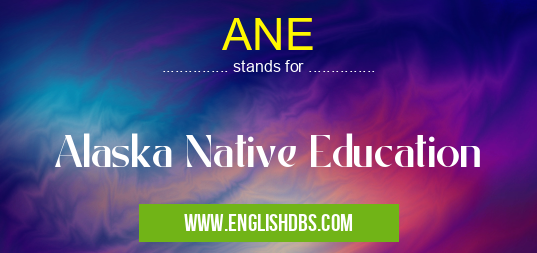What does ANE mean in EDUCATIONAL
ANE stands for Alaska Native Education. It is a field of study that focuses on the educational needs of Alaska Natives, who are the indigenous people of Alaska. ANE programs and services are designed to meet the unique needs of Alaska Native students, who face a variety of challenges, including poverty, language barriers, and cultural differences.

ANE meaning in Educational in Community
ANE mostly used in an acronym Educational in Category Community that means Alaska Native Education
Shorthand: ANE,
Full Form: Alaska Native Education
For more information of "Alaska Native Education", see the section below.
» Community » Educational
ANE Goals
- Provide culturally relevant education that meets the needs of Alaska Native students.
- Increase the number of Alaska Native students who graduate from high school and college.
- Improve the academic achievement of Alaska Native students.
- Prepare Alaska Native students for success in the 21st century workforce.
ANE Programs and Services
ANE programs and services vary depending on the needs of the community. Some common programs and services include:
- Culturally relevant curriculum
- Bilingual education
- After-school programs
- Tutoring
- Counseling
- Financial aid
ANE Challenges
ANE programs and services face a number of challenges, including:
- Funding
- Lack of qualified teachers
- Cultural differences
- Poverty
ANE Successes
Despite the challenges, ANE programs and services have been successful in improving the educational outcomes of Alaska Native students. Some of the successes of ANE programs include:
- Increased high school graduation rates
- Increased college enrollment rates
- Improved academic achievement
- Increased cultural pride
Essential Questions and Answers on Alaska Native Education in "COMMUNITY»EDUCATIONAL"
What is Alaska Native Education (ANE)?
Alaska Native Education (ANE) is a comprehensive educational model designed to meet the unique cultural, linguistic, and academic needs of Alaska Native students from pre-kindergarten through higher education. ANE incorporates traditional Alaska Native knowledge, values, and perspectives into the curriculum, while also adhering to state and national educational standards.
What are the benefits of ANE for Alaska Native students?
ANE provides Alaska Native students with a culturally responsive and supportive learning environment that:
- Enhances their academic achievement
- Preserves and revitalizes their cultural heritage
- Fosters a sense of identity and belonging
- Prepares them for success in higher education and the workforce
How is ANE implemented in schools?
ANE is implemented through a variety of strategies, including:
- Incorporating Alaska Native language and culture into the curriculum
- Using culturally relevant teaching methods
- Providing professional development for teachers on Alaska Native culture and pedagogy
- Establishing partnerships with Alaska Native communities and organizations
What are the challenges to implementing ANE?
Some of the challenges to implementing ANE include:
- Lack of resources and funding
- Limited availability of qualified Alaska Native teachers
- Resistance from some educators who may not understand or value Alaska Native culture
What is the future of ANE?
ANE is an essential component of Alaska's educational system and is expected to continue to grow and evolve in the future. As the Alaska Native population continues to increase, there will be a growing need for educators who are trained in ANE and for schools that provide culturally responsive education for Alaska Native students.
Final Words: ANE is a critical field of study that is helping to improve the educational outcomes of Alaska Native students. ANE programs and services are culturally relevant, and they are designed to meet the unique needs of Alaska Native students. Despite the challenges, ANE programs and services have been successful in improving the educational outcomes of Alaska Native students.
